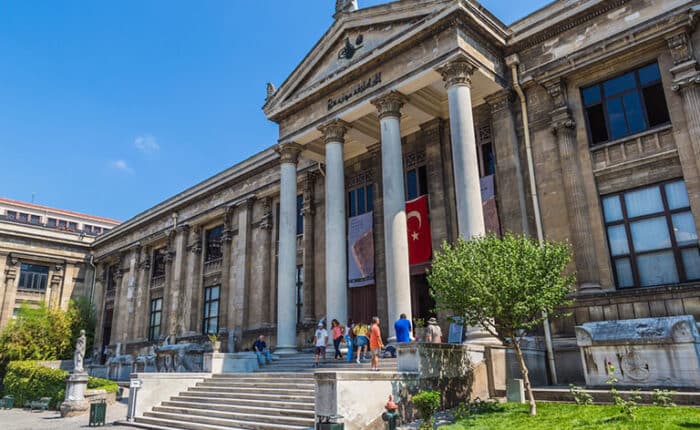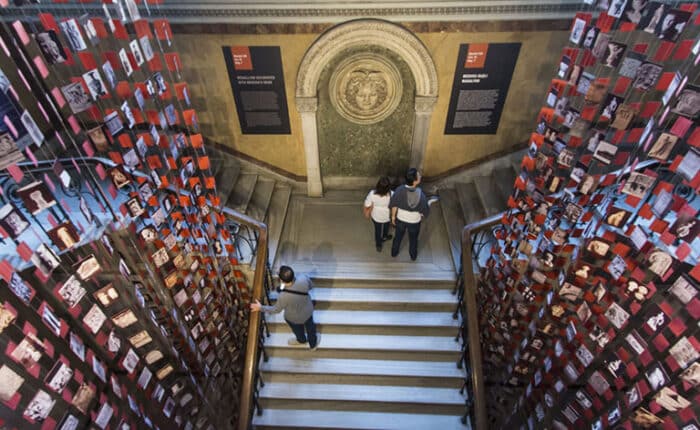The Istanbul Archaeology Museums were founded by decree as the Imperial Museum. The main building was commissioned by Osman Hamdi Bey, a famous painter, who started the construction in 1881, with additions in 1902 and 1908 to gain its current architecture. The building architect was Alexander Vallaury, responsible for designing the Pera Palace Hotel in Istanbul.
The Museum of the Ancient Orient was also commissioned by Hamdi Bey in 1883 and opened as a museum in 1935. On the other hand, the Tiled Pavilion Museum is the oldest building in the complex, commissioned by Sultan Mehmed II in 1472. It served as the Imperial Museum from 1875 to 1891 before the artifacts collection was moved into the just-completed main building. It later opened to the public as a Turkish and Islamic art museum before being incorporated into the complex.
The complex has three main sections; the Archaeology Museum, the Museum of Ancient Orient, and the Tiled Pavilion Museum.
The museum section has two floors in the old building and six in the new. It was designed by the renowned architect Alexandre Vallaury. Artifacts were moved here in 1887-1888 after the Imperial Museum building became inadequate to display all remnants from excavation works on the Necropolis of Sidon. It attained its present neo-Greek form after the construction of the auxiliary units between 1903 and 1907. The building’s facade is inspired by the Sarcophagus of the Mourning Women and the Alexander Sarcophagus.
Around the time of the commissioning of the Istanbul Archaeology Museums, there was an imperial decree protecting artifacts from the Ottoman Empire. Therefore, local governors from all over the empire sent artifacts to Istanbul, enabling the museum to amass a great collection.
Today, the museum houses the largest collection of historical artifacts from all over the world. It has over one million objects from many cultures and every major civilization in world history, including archeological artifacts that date back to 2300 BCE and valuable objects from the Muslim and Arab worlds.
Here are the artifacts via their respective sections:
The Archaeology Museum is home to impressive pieces, many of which were brought here from the excavation of the Necropolis of Sidon. These include the Lycian Sarcophagus, the Mourning Women Sarcophagus, and the Sarcophaguses of Alexander the Great and King Tabnit, which are some of the most valuable pieces in the museum. There is also an exciting exhibition of “Istanbul Through the Ages” and a library with about 70,000 books that are worth your time.
The Museum of the Ancient Orient houses pieces from the pre-Islamic Arabian Peninsula, Anatolia, Egypt, and Mesopotamia. It is home to the Treaty of Kadesh, which was signed in 1274 and is thus, the oldest peace treaty in the world. There is also an 8th century BCE Love Poem from ancient Babylon.
This breathtaking pavilion houses around 2,000 artifacts from the Seljuk and Ottoman periods in Turkey.



Touring the museum complex is a fun experience, especially for lovers of history. This is an excellent place to start if you are interested in the history of the regions covered by the Ottoman Empire. The Archaeological Museum has one of the most impressive neo-classical designs in Istanbul that wows visitors even before they set foot in it.
On the old building’s upper floor, you will get to enjoy interesting artifacts like pots and pans, small statues, and small stone works.
There are also approximately 800,000 Ottoman coins on displays and seals, decorations and medals from all over the Ottoman empire. The massive book collection is also hosted on this floor. On the bottom floor, you will enjoy the most valuable collections in the building- the sarcophaguses.
After the old building, visitors then proceed to the new building where the first floor takes them on a tour of Istanbul through the ages, the second floor on a tour of Anatolia, and the top floor explores the surrounding cultures of Anatolia.
From there, you will then proceed to the Museum of Ancient Orient for a glimpse of the best art pieces from Mesopotamia, ancient Egypt, Anatolia, and the Arab world. The visit will end at the Tiled Pavilion, where you get to enjoy Seljuk and Ottoman ceramics displayed in a breathtaking exhibition room.
How to get there
The Istanbul Archaeological Museums sits in the Sultanahmet neighborhood in the Fatih district. Therefore, you can take a tram or any other form of public transport to Sultanahmet square and walk to the museums, which are only a three-minute walk away.
Open Hours
The museum complex is open every day except on Mondays between 9 am and 8 am from April 1st to October 1st.
From October 1st to April 1st, it is open from 9 am to 6 pm.
Ticket price
A ticket to the museums costs 50 Turkish Lira on location. The ticket counters close one hour to the museums’ closing time.
The museum complex sits in the Sultanahmet neighborhood, meaning loads of magnificent attractions surround it. These include the Blue Mosque, Hagia Sophia, Hagia Irene, Topkapi Palace, Basilica Cistern, and so many more. Therefore, spare some time for these beautiful sites.